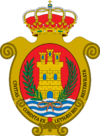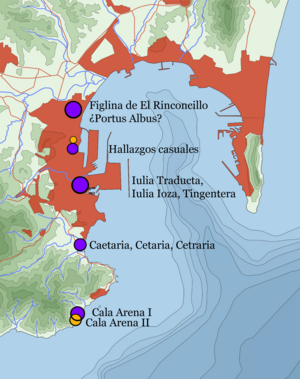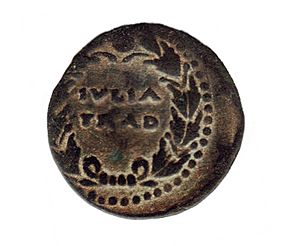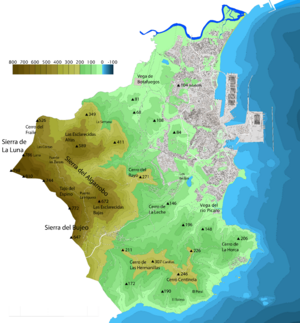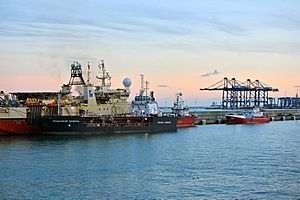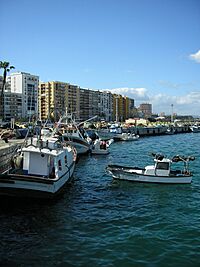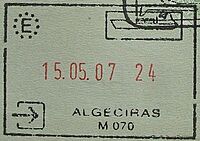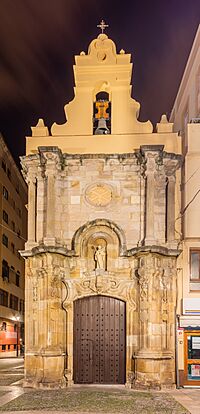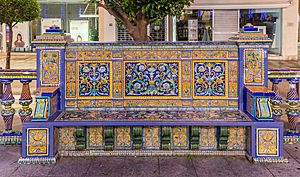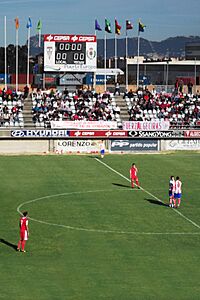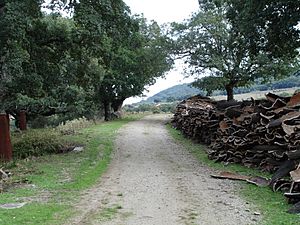Algeciras facts for kids
Quick facts for kids
Algeciras
|
|||
|---|---|---|---|
 |
|||
|
|||
| Country | Spain | ||
| Autonomous community | Andalusia | ||
| Province | Cádiz | ||
| Founded | Pre-Roman | ||
| Area | |||
| • Municipality | 87.96 km2 (33.96 sq mi) | ||
| Elevation | 20 m (70 ft) | ||
| Population
(2018)
|
|||
| • Municipality | 121,414 | ||
| • Density | 1,380.33/km2 (3,575.04/sq mi) | ||
| • Metro | 263,739 | ||
| Demonyms | Algecireño (male) Algecireña (female) |
||
| Time zone | UTC+1 (CET) | ||
| • Summer (DST) | UTC+2 (CEST) | ||
| Postal code |
11200-11209
|
||
| Dialing code | (+34) 956/856 | ||
Algeciras is a city and a municipality in Spain. It belongs to the province of Cádiz in Andalusia. You can find it at the southern tip of the Iberian Peninsula, very close to the Strait of Gibraltar. It's the biggest city on the Bay of Gibraltar.
The Port of Algeciras is one of the busiest ports in Europe and the world. It handles a lot of containers, cargo, and transshipment (moving goods from one ship to another). A small river called the Río de la Miel flows through the city. This river is the southernmost in mainland Europe. In 2020, Algeciras had over 123,000 people, making it the second-largest city in its province. It's part of the comarca (a type of region) called Campo de Gibraltar.
The area around Algeciras also includes other towns like Los Barrios and Tarifa. The total population of this wider area is about 263,739 people.
Contents
- What's in a Name?
- A Look Back: History of Algeciras
- Where is Algeciras? Geography
- How Many People Live Here? Population
- What Algeciras is Known For: Economy
- Fun Things to Do: Tourism
- Getting Around: Transport
- Important Buildings and Places: Monuments
- Fun Events: Celebrations
- Sports Teams
- Learning in Algeciras: Education
- Famous People from Algeciras
- Cities Algeciras is Friends With: Sister Cities
- See also
What's in a Name?
The name Algeciras comes from Arabic. When Muslims settled here after conquering the Iberian Peninsula, they called it al-Jazīrah al-Khaḍrāʾ. This means "The Green Island," referring to Isla Verde, a nearby island.
Before that, the Romans had cities here with names like Portus Albus ("White Harbor") and Iulia Traducta. Later, during the "Byzantine" period, it was known as Mesopotámenoi, meaning "between rivers."
A Look Back: History of Algeciras
The area where Algeciras stands has been home to people for a very long time. Some of the oldest remains found are from Neanderthal people during the Paleolithic era (Stone Age).
Ancient Times and Roman Ports
Because of its great location, Algeciras was an important port for the Phoenicians. Later, the Romans built a key port here called Portus Albus. There were also two nearby Roman cities: Caetaria and Iulia Traducta.
Recently, experts think that the Roman city of Iulia Traducta was located in the Villa Vieja area of Algeciras.
Medieval Period and Viking Raids
After being damaged by the Goths and Vandals, the city was controlled by the Visigothic kingdom. Then, in 711, Tarik landed near Algeciras, beginning the Muslim conquest of the Iberian Peninsula.
In 859 AD, Viking warriors led by Hastein and Björn Ironside attacked Algeciras. They besieged the city for three days, looted homes, and burned mosques. However, the people of Algeciras fought back and managed to drive the invaders away.
Algeciras was briefly an independent state (a taifa) from 1035 to 1058. It was called al-Jazirah al-Khadra' ("Green Island") by the Muslims. This is where the modern name Algeciras comes from.
Sieges and Destruction
In 1278, the Kingdom of Castile, led by Alfonso X of Castile, tried to capture Algeciras. This siege failed, and a Castilian fleet trying to block the harbor was also defeated.
The city became a strong base for the Marinids, a Muslim dynasty, who launched raids from here. In 1309, Ferdinand IV of Castile tried to capture Algeciras again, but it held out for another 30 years.
Finally, in 1342, Alfonso XI of Castile began a second, long siege. Many knights from different countries joined the fight. In March 1344, after several years, Algeciras surrendered.
After the Castilians took the city, it was made the center of a new church area (diocese). However, during the Castilian Civil War, the city was left unprotected. In 1369, the Nasrids from Granada, with help from a Marinid fleet, easily took it back. They ordered the city to be destroyed. The soldiers were moved to Gibraltar, which was easier to defend.
Rebuilding and Modern Times
Algeciras was rebuilt after 1704 by people who had to leave Gibraltar when Anglo-Dutch forces captured it during the War of the Spanish Succession. At first, it was just a few scattered houses among ruins. But after the 1713 Treaty of Utrecht confirmed Gibraltar's capture, people realized they wouldn't return. More settlers came, and the population grew quickly.
The city was fortified to protect against British attacks. In 1760, Charles III rebuilt the city with its current rectangular layout. In 1801, the French and Spanish navies fought the British Royal Navy in the Battle of Algeciras offshore, which the British won.
In 1906, Algeciras hosted an important meeting called the Algeciras Conference. This international meeting discussed the future of Morocco. It confirmed Morocco's independence and gave France control over banking and police there.
During the time of Francisco Franco, Algeciras grew a lot industrially. This created many jobs, especially for workers who lost their jobs when the border between Gibraltar and Spain was closed from 1969 to 1982.
Where is Algeciras? Geography
Location and Surroundings
Algeciras is located at the southern end of the Iberian Peninsula. Its position near the Strait of Gibraltar is very important. This strait is a narrow passage connecting the Atlantic Ocean and the Mediterranean Sea. It's also the closest point between Europe and African continent. This location has always made the port very important. The city itself is on the western side of the Bay of Gibraltar, facing the Rock of Gibraltar.
The municipality covers an area of about 88 square kilometers. It shares borders with the towns of Los Barrios and Tarifa. The Palmones river forms part of the border between Algeciras and Los Barrios.
The group of towns that make up Algeciras and its surrounding areas is the sixth largest in Andalusia.
Climate: Sunny and Mild
Algeciras has a Mediterranean subtropical climate. This means it has very mild, rainy winters and warm, dry summers. Sometimes there are heat waves, but temperatures don't change too much because of the strong influence from the ocean. It hasn't snowed in the city since the 1800s!
| Climate data for Algeciras | |||||||||||||
|---|---|---|---|---|---|---|---|---|---|---|---|---|---|
| Month | Jan | Feb | Mar | Apr | May | Jun | Jul | Aug | Sep | Oct | Nov | Dec | Year |
| Mean daily maximum °C (°F) | 16.1 (61.0) |
16.7 (62.1) |
17.8 (64.0) |
18.9 (66.0) |
21.7 (71.1) |
24.4 (75.9) |
27.2 (81.0) |
27.8 (82.0) |
26.1 (79.0) |
21.7 (71.1) |
18.9 (66.0) |
16.7 (62.1) |
21.2 (70.2) |
| Daily mean °C (°F) | 13.6 (56.5) |
13.9 (57.0) |
15.0 (59.0) |
16.1 (61.0) |
18.7 (65.7) |
21.1 (70.0) |
23.6 (74.5) |
24.2 (75.6) |
23.1 (73.6) |
19.2 (66.6) |
16.4 (61.5) |
14.5 (58.1) |
18.3 (64.9) |
| Mean daily minimum °C (°F) | 11.1 (52.0) |
11.1 (52.0) |
12.2 (54.0) |
13.3 (55.9) |
15.6 (60.1) |
17.8 (64.0) |
20.0 (68.0) |
20.6 (69.1) |
20.0 (68.0) |
16.7 (62.1) |
13.9 (57.0) |
12.2 (54.0) |
15.4 (59.7) |
| Average precipitation mm (inches) | 121.9 (4.80) |
106.7 (4.20) |
106.7 (4.20) |
66.0 (2.60) |
38.1 (1.50) |
10.2 (0.40) |
0.0 (0.0) |
2.5 (0.10) |
25.4 (1.00) |
76.2 (3.00) |
149.9 (5.90) |
132.1 (5.20) |
835.7 (32.90) |
| Source: The Weather Channel | |||||||||||||
| Jan | Feb | Mar | Apr | May | Jun | Jul | Aug | Sep | Oct | Nov | Dec | Year |
|---|---|---|---|---|---|---|---|---|---|---|---|---|
| 16 °C (61 °F) | 15 °C (59 °F) | 16 °C (61 °F) | 16 °C (61 °F) | 17 °C (63 °F) | 19 °C (66 °F) | 22 °C (72 °F) | 22 °C (72 °F) | 22 °C (72 °F) | 20 °C (68 °F) | 18 °C (64 °F) | 17 °C (63 °F) | 18.4 °C (65.1 °F) |
How Many People Live Here? Population
| 1999 | 2000 | 2001 | 2002 | 2003 | 2004 | 2005 | 2006 | 2007 | 2008 | 2009 | 2010 | 2011 | 2012 | 2013 | 2014 | 2015 | 2017 |
|---|---|---|---|---|---|---|---|---|---|---|---|---|---|---|---|---|---|
| 103,106 | 104,087 | 105,066 | 106,710 | 108,779 | 109,665 | 111,283 | 112,937 | 114,012 | 115,333 | 116,209 | 116,417 | 117,810 | 116,917 | 114,277 | 117,974 | 118,920 | 121,133 |
What Algeciras is Known For: Economy
Algeciras is mainly a place for transport and industry. Its most important activities are linked to the Port of Algeciras. This port is the main place to catch a ferry between Spain and Tangier in Morocco, as well as other ports like the Canary Islands and the Spanish cities of Ceuta and Melilla. It's ranked as the 16th busiest port in the world!
The city also has a good fishing industry. It exports many farm products from the nearby areas, such as grains, tobacco, and farm animals.
In recent years, Algeciras has become a popular place for tourists. People enjoy day trips to Tarifa to watch bird migrations. They also visit Gibraltar to see its famous sights and culture. Another popular activity is whale watching excursions in the Bay of Gibraltar.
Algeciras is the end point for two major European roads, the E05 and E15. These roads go all the way to Scotland, passing through France and England.
Fun Things to Do: Tourism
Here are some interesting places to visit:
- Parque Natural del Estrecho (Strait Natural Park)
- Parque Natural Los Alcornocales (Cork Oak Natural Park)
Getting Around: Transport
Buses in the City
The local bus system is run by C.T.M. (Cooperativa de transporte de Marruecos). There are many bus lines that connect different parts of the city:
- Line 1: Bajadilla-Pajarete
- Line 2: Colinas-San Bernabé-Reconquista
- Line 3: Rinconcillo
- Line 4: La Granja
- Line 5: Bahía de Algeciras
- Line 6: Juliana
- Line 7: Saladillo
- Line 8: San García-Saladillo
- Line 9: San García Directo
- Line 10: El Cobre
- Line 11: La Piñera
- Line 12: San García playa
- Line 16: Cementerio-Centro Penitenciario
- Line 18: Cortijo Vides-Piñera
- Line 19: Puerto-S.J.Artesano-Rinconcillo
- Line 21: San García – Residencia – Puerto – Parque
Trains
The Algeciras Gibraltar Railway Company built the Algeciras-Bobadilla railway line. This line connects Algeciras railway station to Bobadilla and then to the rest of Spain. The train line ends near the port of Algeciras.
Roads
Major roads serving Algeciras include:
- European route E15
- European route E05
- Autopista AP-7
- Autovía A-48
- N-340
- GR 7
Buses Between Cities
The main bus station is right next to the train station. Many bus companies offer services to and from Algeciras, connecting it to other cities.
Airports Nearby
The closest airports are:
- Gibraltar Airport – about 20 km away
- Jerez Airport – about 100 km away
- Málaga Airport – about 120 km away
There is also the Algeciras Heliport being built for helicopter transport to Ceuta and other nearby areas.
Important Buildings and Places: Monuments
- Hornos Romanos del Rinconcillo (Roman furnaces from the first century B.C.)
- Factoría de salazones de la calle San Nicolás (Salt meat factory from the first century)
- La Villa Vieja, torres de la Huerta del Carmen (Old Town, Carmen Garden towers from the tenth century)
- Parque Arqueológico de las Murallas Meriníes (Marinid Walls Archeological Park from the thirteenth century)
- Capilla de Nuestra Señora de Europa (Chapel of Our Lady of Europe, built in 1690)
- Iglesia de Nuestra Señora de la Palma (Church of Our Lady of La Palma, built in 1736)
- Hospital de La Caridad (Charity Hospital, built in 1748)
- Capilla de la Caridad (Charity Chapel, built in 1752)
- Casa Consistorial (City Council building, built in 1756)
- Capilla de San Servando (Chapel of San Servando, built in 1774)
- Capilla del Santo Cristo de la Alameda (Chapel of the Holy Christ of Alameda, built in 1776)
- Plaza Alta (Main Square, built in 1807)
- Mercado de Abastos de Algeciras (Algeciras Market, designed by engineer Eduardo Torroja Miret in 1935)
- Art School Building (built in 1971 by architect Fernando Garrido Gutiérrez)
- Faro de Isla Verde (Isla Verde Lighthouse, built in 1864)
- Hotel Reina Cristina (built in 1901)
- District de San Isidro (a typical neighborhood designed in the twentieth century)
Fun Events: Celebrations
- Arrastre de latas (Dragging of Cans) on January 5th.
- Feria Real de Algeciras (Royal Fair of Algeciras) in June.
- Fiestas patronales en honor de Ntra. Sra. la Virgen de la Palma (Patron Saint Festivities in honor of Our Lady the Virgin of La Palma) in August.
- Fiesta de los Tosantos (All Saints' Day celebration) on November 1st.
- Carnival of Algeciras.
Sports Teams
Algeciras CF is the city's association football (soccer) club, founded in 1912. They usually play in the third-tier Segunda División B. They play their home games at the Estadio Nuevo Mirador.
Algeciras BM was a professional handball club that played in the top league, Liga ASOBAL, from 2005 to 2008. The team was later dissolved.
Learning in Algeciras: Education
University of Cádiz – Algeciras Campus
The University of Cádiz has several education centers in Algeciras:
- Escuela Politécnica Superior de Algeciras (Higher Polytechnic School of Algeciras)
- Escuela Universitaria de Enfermería de Algeciras (University School of Nursing of Algeciras)
- Escuela Universitaria de Estudios Jurídicos y Económicos del Campo de Gibraltar "Francisco Tomás y Valiente" (University School of Legal and Economic Studies of Campo de Gibraltar)
- Escuela Universitaria de Magisterio "Virgen de Europa" (University School of Teaching "Virgen de Europa")
- Centro Universitario de Derecho de Algeciras (CUDA) (University Center of Law of Algeciras)
- Campus Bahia de Algeciras
Famous People from Algeciras
- Yahya Ibn Yahya
- Paco de Lucía (a famous guitarist)
- Ramón de Algeciras
- Al-Mansur Ibn Abi Aamir
- Ana Belén Palomo
- Cristóbal Delgado Gómez
- José María Sánchez-Verdú
- Álvaro Morte
- Canelita
Cities Algeciras is Friends With: Sister Cities
Algeciras has "sister city" relationships with:
- Ceuta, Spain
- Neda, Spain
- Dakhla, Western Sahara
See also
 In Spanish: Algeciras para niños
In Spanish: Algeciras para niños



